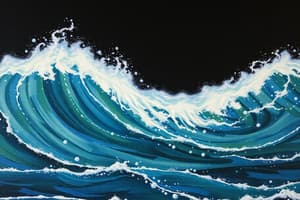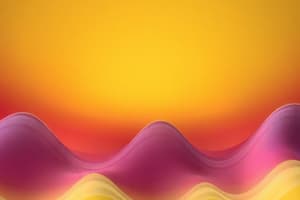Podcast
Questions and Answers
What type of wave is a sound wave?
What type of wave is a sound wave?
- Seismic wave
- Transverse wave
- Electromagnetic wave
- Longitudinal wave (correct)
What is a compression in the context of sound waves?
What is a compression in the context of sound waves?
- A region of lower density and pressure
- The absence of particles
- A point of complete silence
- A region of higher density and pressure (correct)
What is a rarefaction?
What is a rarefaction?
- A region where particles are closely packed together
- A region of lower density and pressure (correct)
- A region of higher density and pressure
- A point of maximum intensity
What is the definition of vibration?
What is the definition of vibration?
Through which medium do sound waves travel fastest?
Through which medium do sound waves travel fastest?
Can sound travel through a vacuum?
Can sound travel through a vacuum?
What primarily determines if a sound is loud or soft?
What primarily determines if a sound is loud or soft?
How does increased density of a medium affect the speed of sound?
How does increased density of a medium affect the speed of sound?
How does increased temperature of a medium affect the speed of sound?
How does increased temperature of a medium affect the speed of sound?
What is reflection of sound waves?
What is reflection of sound waves?
What is an echo?
What is an echo?
What kind of wall causes sound waves to easily reflect?
What kind of wall causes sound waves to easily reflect?
What is echolocation?
What is echolocation?
For an echo to occur, approximately how far away must the reflecting surface be?
For an echo to occur, approximately how far away must the reflecting surface be?
What is ultrasonography used for?
What is ultrasonography used for?
What is sonar?
What is sonar?
Why are ultrasonic waves used instead of X-rays?
Why are ultrasonic waves used instead of X-rays?
What happens during resonance?
What happens during resonance?
What is the key factor that determines sound quality?
What is the key factor that determines sound quality?
Why can you tell apart the sound of a violin from the sound of a piano?
Why can you tell apart the sound of a violin from the sound of a piano?
Flashcards
Sound Wave
Sound Wave
A longitudinal wave made of compressions and rarefaction caused by vibrations through a material medium.
Compression (Sound)
Compression (Sound)
Compressions occur where air particles are pushed closer together, creating a region of higher density and pressure.
Rarefaction (Sound)
Rarefaction (Sound)
Rarefaction occurs where air particles are more spread out, creating a region of lower density and pressure.
Vibration
Vibration
Signup and view all the flashcards
Characteristics of Sound Waves
Characteristics of Sound Waves
Signup and view all the flashcards
Sound Properties
Sound Properties
Signup and view all the flashcards
Factors Affecting Sound Speed
Factors Affecting Sound Speed
Signup and view all the flashcards
Reflection of Sound Waves
Reflection of Sound Waves
Signup and view all the flashcards
Echo
Echo
Signup and view all the flashcards
Echolocation
Echolocation
Signup and view all the flashcards
When does an Echo Occur?
When does an Echo Occur?
Signup and view all the flashcards
Ultrasonography
Ultrasonography
Signup and view all the flashcards
Sonar
Sonar
Signup and view all the flashcards
Uses of Ultrasonography
Uses of Ultrasonography
Signup and view all the flashcards
Why Use Ultrasonic Waves instead of X-rays?
Why Use Ultrasonic Waves instead of X-rays?
Signup and view all the flashcards
Resonance
Resonance
Signup and view all the flashcards
Sound Quality
Sound Quality
Signup and view all the flashcards
Sound Needs a Medium
Sound Needs a Medium
Signup and view all the flashcards
Why do ultrasonic waves produce images of object inside the body effectively?
Why do ultrasonic waves produce images of object inside the body effectively?
Signup and view all the flashcards
Why does the speed of sound in air depends on the temperature?
Why does the speed of sound in air depends on the temperature?
Signup and view all the flashcards
Study Notes
Sound Waves
- Sound waves are longitudinal waves composed of compressions and rarefactions.
- Vibrations that travel through a material medium cause these waves.
Compression
- Compressions occur when air particles are pushed closer together, creating regions of higher density and pressure.
Rarefaction
- Rarefactions happen when air particles are less crowded, resulting in regions of lower density and pressure.
Vibration
- Vibration is the complete back-and-forth motion of an object.
Characteristics of Sound Waves
- Travel in all directions: Sound waves travel away from their source.
- Travel Through Matter: Sound waves can travel through gases, liquids, and solids.
- Speed: They travel fastest in solids, slower in fluids and slowest in gases.
- Vacuum: Sound cannot travel through a vacuum.
- Representation: Sound waves cannot actually be seen, but they can be represented by spheres.
Sound Properties
- Differences in sounds depend on properties of the sound waves, accounting for why some sounds are loud, soft, high, or low.
How to Alter the Speed of Sound
- Density: Increasing the density of the medium (solid, liquid, or gas) increases the speed of sound.
- Temperature: Increasing the temperature of the medium (solid, liquid, or gas) increases the speed of sound.
Reflection of Sound Waves
- Sound waves bounce back when they strike a barrier in a process called reflection.
Echo
- An echo is a reflected sound wave.
Reflection in Gymnasiums
- Sound waves easily reflect off a gymnasium wall because gymnasiums typically have smooth, hard walls.
Echolocation
- Echolocation is the process of using reflected sound waves to locate objects; animals like bats, Beluga whales, and dolphins use echolocation.
Conditions for Echoes
- Distance: The distance between the sound source and reflecting surface must be at least 17 meters.
- Time Period: The time period between hearing the original sound and its echo should not be less than 0.1 seconds.
Measuring distance using Echos
- Echoes can measure distance or depth using the formula d = s x ½ t.
Echolocation Dependence
- Echolocation depends on how long it takes those sound waves to return to the ears.
Ultrasonography
- Ultrasonography is a medical procedure using echoes to see inside a patient’s body without surgery.
Sonar
- Sonar is a type of electronic echolocation.
Uses of Ultrasonography
- Medical Examination: Used to examine organs such as the kidneys and gallbladders and other organs.
- Prenatal Care: Used to check the development of an unborn baby.
Ultrasonic Waves vs. X-rays
- Detail: Ultrasonic waves give more detailed images due to their shorter wavelengths.
- Safety: Less harmful to human tissue than X-rays.
Resonance
- Resonance happens when a vibrating object causes a second object to vibrate because they have the same resonant frequency.
Sound Quality
- The difference has to do with its sound quality.
Distinguishing Sounds
- Instruments can seem different because they produce different sounds comprised of a few pitches.
Sound Travel
- Sound waves cannot travel through a vacuum.
Correct Answers:
- A laboratory experiment about the nature of sound; Sara observes a large, dark room with a strong echo and smooth, hard walls with few things in it (A).
- Sound travels fastest through glass (D).
Other Points
- For a man standing in front of a wall 360 m away who hears an echo after 2 seconds, the speed of sound is 360 m/s.
- If a man stands in front of a mountain, and a sound is heard after 2 seconds, the distance between the man and the mountain is 340 m.
Understanding Resonance
- Resonance occurs when a vibrating object near a second object causes the second object to vibrate.
Effectiveness of Ultrasonic Waves
- Ultrasonic waves are effective at producing images of objects inside the body because their short wavelengths can image small objects.
How the speed of sound changes dependent on temperature
- Molecules that have more motion (more energy and higher temperature) are able to transfer their vibrations more easily.
- This is less noticeable in liquids and solids because the particles are closer together.
Speed of Sound in Air Table Examples
- At 0°C, v = 331 + 0.6(0) = 331 m/s.
- At 20°C, v = 331 + 0.6(20) = 343 m/s.
- At 25°C, v = 331 + 0.6(25) = 346 m/s.
- At 100°C, v = 331 + 0.6(100) = 391 m/s.
Studying That Suits You
Use AI to generate personalized quizzes and flashcards to suit your learning preferences.




